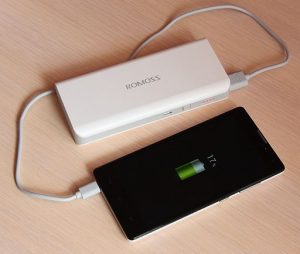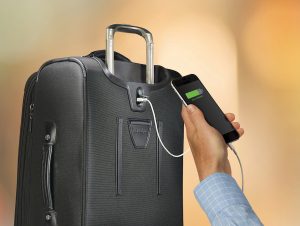File this under the category “Now We’ve Heard Everything.” According to an article in Smarter Travel, the latest scam to target travelers involves what’s called “juice-jacking.” Travelers desperate for a charge plug into a public charging station that, unbeknownst to them, is masquerading as a data port to steal their phone’s private and personal data.
Once a phone is connected to the station, everything on the device is downloadable: passwords, photos, emails, messages, bank account information. Worse yet, additional malware might also be infecting the device. How can you protect yourself against this new hacking method?

Using a battery pack instead of an almost-too-convenient charging station can help you avoid the juice-jacking travel scam.
For one thing, be wary of public USB-friendly charging stations. There’s a chance that it’s a bogus charging station, and instead of just charging your batteries, you could give hackers access to your mobile device.
Instead, always travel with your own power pack. Some of our new Crew™ 11 Carry-on models feature a built-in battery pocket and external USB port. No more digging for your accessories or relying on potentially unsafe charging stations. Just plug your battery into the internal charging USB cord, and then plug your normal charging cord into the port on the back of your luggage.
When purchasing a battery pack, there are numerous styles to choose from, including several credit card size chargers. You can charge them on your laptop in a couple of hours, and then keep them in your briefcase, purse, or even your jacket pocket. They’ll nearly charge an iPhone or Android, which will buy you a few more hours until you can get to a regular wall charger.
You can also plug into your laptop and charge up. Even if you need to drain off some of your laptop battery to keep your phone going, it’s a better option than plugging into an unknown charger. You can even plug your laptop into the charging station’s 3-prong outlet, and plug your phone into your laptop, because data can’t transfer over a normal laptop plug-and-brick charger.

The Crew 11’s built-in power port is a great way to keep your mobile devices powered up and ready to go.
Finally, use the charging cube that came with your phone and plug into a standard wall socket. If you must use a public charging station, invest in a USB charge-only cable. These are special cables that don’t have a data wire in them, so you can plug them in anywhere and never worry about hackers breaking into your phone. Buy a non-white one on Amazon, or label it, so you can tell it apart from your normal data cable.
We’re not saying that every public charging station is unsafe, but it’s better to be safe than sorry. Just plan ahead a little bit, and don’t trust every public charging station you see.
How do you charge your phone on the run? What steps do you take to make sure everything is secure? Let us hear from you in the comments below, on our Facebook page, or in our Twitter stream.
Photo credit: Ilya Plekhanov (Wikimedia Commons, Creative Commons 3.0)
